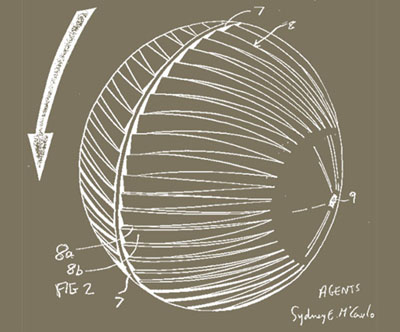Development History
The design of the Hydro-Electric-Barrel evolved from this amphibious vehicle that I designed and built back in the 70’s.
When testing the vehicle a surprising design flaw became apparent.On water at speeds of less than 4 mph (6.5 kph) everything rolled along just fine but when the throttle was opened past this point instead of going faster the vehicle started going down.
This was due to the Coanda Effect.
Clearly some method of overcoming this down-force was needed. A method of breaking the water suction.
 A 3 foot (91cm) diameter ball with axle bearings was made. When towed behind a boat it was found that at speeds over 4 mph (6.5 kph) the ball began to dive and would behave more like an anchor even though it was mounted on free rotating axle bearings and was otherwise very bouyant.
A 3 foot (91cm) diameter ball with axle bearings was made. When towed behind a boat it was found that at speeds over 4 mph (6.5 kph) the ball began to dive and would behave more like an anchor even though it was mounted on free rotating axle bearings and was otherwise very bouyant.
After adding a chevron tread pattern similar to that now shown on the hydro-electric-barrel a speed of 16 mph (26 kph) was acheived and the ball span readily on the water surface.
A straight tread did not solve the problem effectively due to downward force applied by the treads as they emerged from the water.
I played around with a few designs for ball wheeled vehicles before lack of time and money took over and the project was shelved.
 While testing the ball at a water shoot at a local swimming baths the idea was born that it could produce power if the paddle tread were deeper. Many years later as the need for renewable energy sources has increased I began to consider the use of this design to produce power as commercially viable.
While testing the ball at a water shoot at a local swimming baths the idea was born that it could produce power if the paddle tread were deeper. Many years later as the need for renewable energy sources has increased I began to consider the use of this design to produce power as commercially viable.